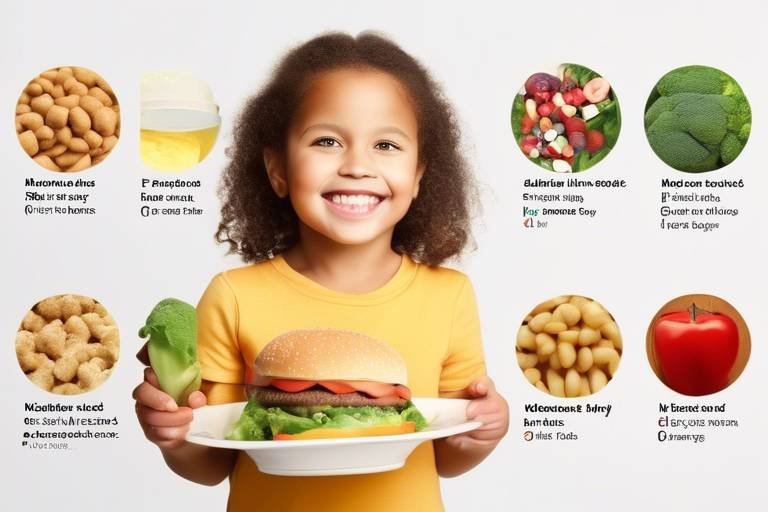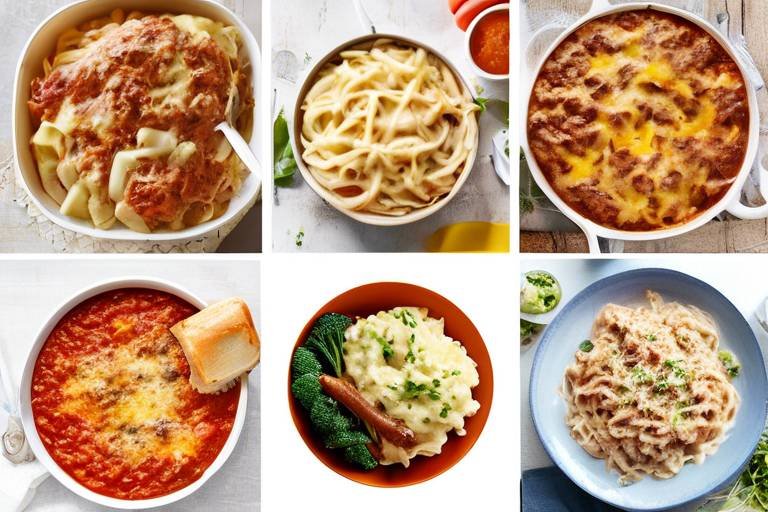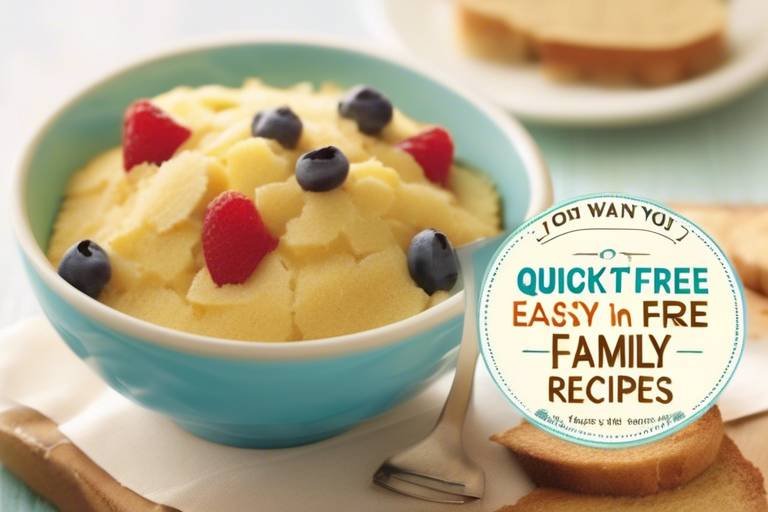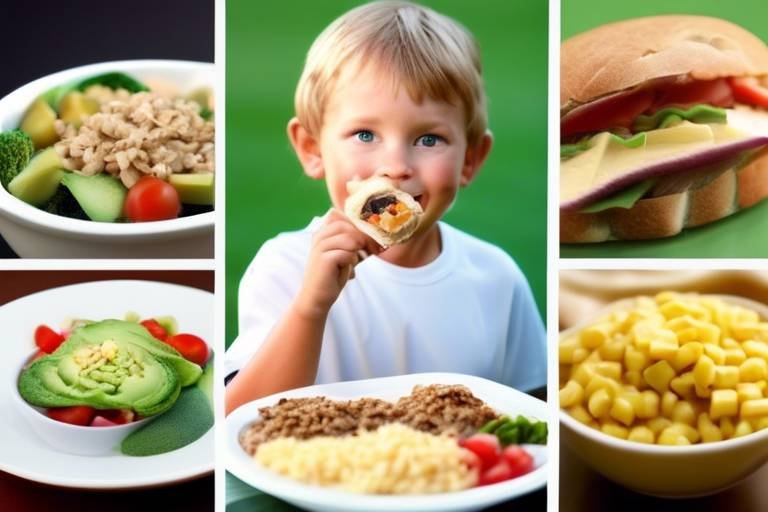Nutritious Substitutes for Your Child's Favorite Foods
As parents, we often find ourselves navigating the tricky waters of our children's eating habits. It can feel like a daily battle to get them to consume the right nutrients without sacrificing their beloved meals and snacks. The good news? You can explore healthier alternatives to common children's meals that not only maintain the taste but also boost their nutrition. Imagine being able to swap out that sugary cereal for something equally delicious but packed with vitamins! This guide is here to help you discover practical ideas for improving your child's diet while ensuring that mealtime remains a fun and enjoyable experience.
Children's taste buds are often drawn to familiar flavors, which can make it challenging to introduce healthier options. However, with a little creativity and some knowledge of their nutritional needs, you can make significant changes without them even noticing. Think of it as a culinary adventure—an opportunity to sneak in those vital nutrients while keeping the joy of eating alive. So, buckle up as we dive into some fantastic substitutes that will make your child's meals both nutritious and delightful!
Before we jump into the fun part of substitutions, it’s essential to understand what your child needs nutritionally. Children require a balanced diet rich in proteins, carbohydrates, healthy fats, vitamins, and minerals to support their growth and development. This means incorporating a variety of foods from all food groups. When you know what your child needs, it becomes easier to make informed choices when substituting their favorite foods. For instance, replacing white bread with whole grain not only adds fiber but also keeps them fuller for longer. It’s like giving their bodies a superhero cape—equipping them to conquer the day!
Snacks play a crucial role in a child's diet, providing energy and nutrients between meals. Instead of reaching for the usual chips or sugary treats, consider these nutritious snack alternatives:
- Fruit and Yogurt Parfaits: Layer Greek yogurt with fresh fruits and a sprinkle of granola for a satisfying snack.
- Veggie Sticks with Hummus: Crunchy vegetables like carrots and cucumbers paired with hummus make for a deliciously healthy dip.
- Nut Butter on Whole Grain Crackers: Spread almond or peanut butter on whole grain crackers for a protein-packed option.
These snacks not only satisfy cravings but also ensure that your child receives essential vitamins and minerals. Plus, they’re easy to prepare, making them perfect for busy parents!
We all know that sugary beverages can lead to various health issues, including obesity and dental problems. So, how can you quench your child's thirst while reducing their sugar intake? Consider these healthier drink options:
- Infused Water: Add slices of fruits like lemon, strawberries, or cucumbers to water for a refreshing twist.
- Homemade Smoothies: Blend fruits with yogurt or milk for a creamy, nutritious drink.
- Herbal Teas: Naturally caffeine-free and available in various flavors, herbal teas can be a delightful alternative.
By swapping out sugary drinks for these options, you can help your child stay hydrated and healthy without the unnecessary sugar rush!
Breakfast is the most important meal of the day, especially for energetic kids. Instead of sugary cereals or pancakes drenched in syrup, how about transforming traditional breakfast items into healthier versions? For example, consider whole grain pancakes topped with fresh fruit instead of syrup. Or how about oatmeal made with milk, topped with nuts and berries? It’s like giving their morning a nutritious makeover!
Packing a nutritious lunch can be challenging, but it doesn't have to be boring! Get creative with your child's lunchbox by incorporating healthy substitutes for their classic favorites. Think whole grain wraps filled with lean proteins and colorful veggies, or homemade pizza on whole grain pita topped with tomato sauce and lots of veggies. The key is to make it visually appealing and fun! A little presentation goes a long way in making healthy choices exciting.
Dinner is the perfect opportunity to introduce a variety of healthy foods. You can replace common dinner items with nutritious alternatives that are still delicious. For example, swap out white rice for quinoa or cauliflower rice, and replace fatty cuts of meat with grilled chicken or fish. It’s like turning a regular meal into a gourmet experience! Encourage your child to embrace diverse flavors and ingredients by involving them in the cooking process.
Let’s face it—desserts are often the highlight of a child's day. But you can create healthier dessert options that satisfy their sweet cravings without excessive sugar. Think about using natural sweeteners like honey or maple syrup, or even better, using ripe bananas or applesauce in baked goods. You can make delicious fruit popsicles by blending fruits and freezing them in molds. It’s a win-win situation where they get to indulge while you feel good about their choices!
One of the best strategies to foster healthier eating habits is to involve your children in meal planning. When they have a say in what they eat, they’re more likely to accept healthier substitutes. Take them grocery shopping and let them pick out fruits and vegetables they want to try. You could also have a fun cooking night where they help prepare meals. This not only teaches them about nutrition but also creates lasting memories in the kitchen!
1. What are some easy substitutes for common snacks?
You can try replacing chips with air-popped popcorn or fruit slices with nut butter instead of candy bars.
2. How can I make my child's favorite meals healthier?
Use whole grain options, incorporate more vegetables, and try to reduce the amount of added sugar and salt.
3. Are there any healthy dessert recipes for kids?
Yes! You can make banana pancakes, yogurt parfaits, or fruit smoothies that are both healthy and delicious.
4. How can I encourage my child to drink more water?
Make water fun by adding fruits for flavor or using colorful straws and fun cups to make it more appealing.

Understanding Nutritional Needs
As parents, we often find ourselves navigating the complex world of nutrition for our children. Understanding what our little ones need is crucial for their growth and development. Children are like little engines; they require the right fuel to keep running smoothly. Their bodies are in a constant state of change, from growing taller to developing new skills, and this requires a balanced diet filled with essential nutrients.
So, what exactly do children need? Well, their nutritional needs can be broken down into several key components:
- Proteins: These are the building blocks of the body. They help in the growth and repair of tissues. Good sources include lean meats, dairy, beans, and nuts.
- Carbohydrates: This is the primary energy source for kids. Whole grains, fruits, and vegetables are excellent choices that provide lasting energy.
- Fats: Healthy fats are essential for brain development. Foods like avocados, olive oil, and fish are great options.
- Vitamins and Minerals: These are crucial for various bodily functions. A colorful plate filled with fruits and vegetables typically ensures your child gets a range of these nutrients.
When considering substitutions for your child's favorite foods, it's important to ensure that these nutritional needs are met without compromising taste. For example, instead of serving traditional pasta, you might consider whole grain or vegetable-based options that offer more fiber and nutrients. Similarly, when it comes to snacks, think about swapping out sugary treats for fruit or yogurt, which can provide the sweetness kids crave while also delivering vitamins and minerals.
Furthermore, hydration plays a significant role in a child's overall health. Water should be the primary beverage, but you can also introduce nutrient-rich drinks like smoothies or infused waters that keep kids excited about hydration while reducing their intake of sugary sodas and juices.
In summary, understanding your child's nutritional needs is the first step in making informed food choices. By focusing on providing a balanced diet filled with the right nutrients, you can help your child thrive. Remember, incorporating healthy substitutes doesn't mean sacrificing flavor; it means being creative and adventurous in the kitchen!

Healthy Snack Alternatives
Snacks play a pivotal role in a child's diet, serving as a bridge between meals and providing essential energy for their active lifestyles. However, many traditional snacks are laden with sugars and unhealthy fats, which can lead to energy crashes and poor nutritional habits. The good news is that there are plenty of nutritious snack alternatives that are not only healthy but also delicious and appealing to young taste buds. Imagine swapping out those sugary granola bars for homemade fruit and nut bites that are bursting with flavor and nutrients!
One of the easiest ways to make snacks healthier is by incorporating whole foods that are rich in vitamins and minerals. For instance, instead of reaching for chips, consider offering air-popped popcorn seasoned with a sprinkle of nutritional yeast for a cheesy flavor. Not only is it a fun snack, but it also provides fiber and essential nutrients. Another great alternative is to replace sugary yogurt with plain Greek yogurt, which is packed with protein. You can sweeten it naturally with honey or fresh fruits, making it a delightful treat that kids will love.
Fruits and vegetables can also be transformed into exciting snacks. Think about creating a colorful fruit kabob with strawberries, bananas, and grapes, or making vegetable sticks with hummus for dipping. These snacks are not just visually appealing; they also encourage kids to consume more fruits and veggies without them even realizing it! Here’s a quick comparison of common snacks and their healthier alternatives:
| Traditional Snack | Healthy Alternative |
|---|---|
| Potato Chips | Kale Chips |
| Cookies | Oatmeal Raisin Energy Bites |
| Fruit Snacks | Homemade Fruit Leather |
| Ice Cream | Frozen Yogurt Bark |
By offering these alternatives, not only do you improve the nutritional value of your child's snacks, but you also open the door for them to explore new flavors and textures. It’s all about making healthy eating fun and exciting. You might even find that your kids enjoy helping to prepare these snacks, turning the process into a family activity that encourages them to take ownership of their food choices.
So, the next time your little ones come asking for a snack, be ready with some healthy options that will keep their energy levels high and their bodies nourished. Remember, it’s not just about substituting one item for another; it’s about creating a positive relationship with food that lasts a lifetime!

Substituting Sugary Drinks
When it comes to keeping your child hydrated, sugary drinks often lead the charge, but they can do more harm than good. High sugar content in sodas and fruit juices can contribute to weight gain, dental issues, and even energy crashes. So, how do we navigate this sugary landscape without sacrificing taste? The answer lies in exploring healthier alternatives that are not only refreshing but also packed with essential nutrients.
One of the simplest substitutions is to swap out soda for sparkling water. Not only does sparkling water offer that fizzy sensation kids love, but it can also be flavored with fresh fruits such as lemons, limes, or berries. This not only adds a burst of flavor but also infuses the drink with vitamins. Imagine your child sipping on a glass of sparkling water with a slice of lemon, feeling like they are indulging in a special treat, while you know they are making a healthier choice!
Another fantastic alternative is to introduce homemade smoothies. These can be a fun and colorful way for kids to get their daily servings of fruits and vegetables. You can use a base of yogurt or milk, toss in some spinach or kale (trust me, they won’t even taste it!), and blend in their favorite fruits. Not only will they enjoy a delicious drink, but they will also be getting a dose of protein, fiber, and essential vitamins. Plus, smoothies can be a creative outlet for kids to experiment with different flavors and textures!
For those hot summer days, consider making fruit-infused water. Just fill a pitcher with water and add slices of fruits like oranges, strawberries, or cucumbers. Let it sit in the fridge for a few hours, and you’ll have a refreshing drink that’s both tasty and hydrating. This is a great way to encourage kids to drink more water without the added sugars and calories found in commercial beverages.
It's also important to educate children about the effects of sugary drinks. Sometimes, a simple conversation can go a long way. Discuss how sugar can impact their energy levels and how choosing healthier drinks can help them feel more energetic and focused. You might even turn it into a fun experiment by letting them feel the difference in their energy levels after drinking sugary drinks versus healthier alternatives.
To help you visualize these alternatives, here’s a quick comparison of common sugary drinks versus healthier substitutes:
| Drink Type | Sugary Option | Healthier Substitute |
|---|---|---|
| Soda | Regular Cola | Sparkling Water with Fresh Fruit |
| Fruit Juice | 100% Orange Juice | Homemade Smoothie |
| Sports Drinks | Commercial Sports Drink | Coconut Water |
| Iced Tea | Sweetened Iced Tea | Herbal Iced Tea with Lemon |
In conclusion, substituting sugary drinks doesn’t have to be a battle. With a little creativity and some fun options, you can encourage your child to make healthier beverage choices that taste great. Remember, it’s all about making small changes that can lead to lasting habits. So, the next time your child asks for a sugary drink, you’ll be ready with a delicious and nutritious alternative!

Revamping Breakfast Favorites
Breakfast is often dubbed the most important meal of the day, and for good reason! It sets the tone for your child's energy levels and mood throughout the day. However, many traditional breakfast favorites can be loaded with sugar and unhealthy fats, making it essential to find healthier alternatives that still maintain that delicious taste kids love. So, how can you revamp those breakfast staples without a fight at the breakfast table?
One fantastic way to start the day is by swapping out sugary cereals for whole grain options. Whole grain cereals are not only packed with fiber, but they also provide sustained energy, preventing those mid-morning crashes that can leave kids feeling sluggish. You can even jazz them up by adding fresh fruits like berries or bananas, which not only enhance the flavor but also boost the nutritional value. Imagine a colorful bowl of crunchy whole grain cereal topped with vibrant berries—what kid could resist?
Another classic breakfast item that can use a makeover is the pancake. Instead of traditional pancakes made with white flour, try using whole wheat or oat flour. You can sneak in some mashed bananas or applesauce into the batter for natural sweetness and moisture. Top these pancakes with a dollop of Greek yogurt and a drizzle of honey or pure maple syrup for a delightful twist that’s both tasty and nutritious. It's like giving pancakes a superfood upgrade!
Eggs are a breakfast staple that can be prepared in countless ways, making them a versatile option for your child's morning meal. Consider making a veggie-packed omelet or scrambled eggs with spinach, tomatoes, and bell peppers. Not only do these additions provide essential vitamins and minerals, but they also add a burst of color and flavor to the plate. Plus, involving your child in the cooking process can make them more excited about eating their greens!
For those busy mornings when time is of the essence, overnight oats can be a game-changer. Simply combine rolled oats with milk or yogurt and let them soak overnight. In the morning, add your child's favorite toppings—think nuts, seeds, or dried fruits—and you’ve got a nutritious breakfast ready to go! It’s like having a delicious dessert for breakfast, but without the guilt. And let’s face it, who doesn’t love a sweet treat to start the day?
Lastly, smoothies are an excellent way to pack in nutrition while keeping breakfast fun. Blend together some spinach, a banana, a scoop of nut butter, and a splash of almond milk for a creamy, delicious drink that feels like a treat but is loaded with nutrients. You can even freeze some fruits ahead of time, making it a quick grab-and-go option for those hectic mornings.
In conclusion, revamping breakfast favorites doesn't have to be a daunting task. With a little creativity and some simple substitutions, you can transform traditional meals into healthy, delicious options that your children will love. Remember, the goal is to make breakfast enjoyable and nutritious, ensuring that your little ones start their day off right!
Q: How can I encourage my child to try healthier breakfast options?
A: Involve them in the cooking process! Let them pick out fruits or toppings, or even help with the preparation. Making breakfast a fun activity can spark their interest in trying new foods.
Q: Are there quick breakfast options for busy mornings?
A: Absolutely! Overnight oats and smoothies are both quick and nutritious. You can prepare them the night before, so they're ready to go in the morning.
Q: What are some good sources of protein for breakfast?
A: Eggs, Greek yogurt, and nut butters are all excellent sources of protein that can keep your child full and satisfied throughout the morning.

Creative Lunchbox Ideas
When it comes to packing a lunchbox for your little one, the challenge is not just about making it nutritious but also about keeping it fun and exciting. Let’s face it, kids can be picky eaters, and if their lunch looks boring, they might just trade it for a friend’s snack or, worse, leave it untouched. So, how can we turn a mundane lunch into a delightful culinary adventure? Here are some creative ideas that will not only please their taste buds but also ensure they’re getting the nutrients they need!
First off, think outside the traditional sandwich box. Instead of the usual bread, why not try whole grain wraps or even lettuce leaves? This way, you can fill them with a variety of colorful veggies, lean proteins, and tasty spreads. Imagine a wrap filled with hummus, shredded carrots, and slices of turkey, all rolled up in a spinach wrap. It’s not only visually appealing but also packed with vitamins and minerals!
Another fun idea is to create a bento box style lunch. This Japanese-inspired lunch trend allows you to pack a variety of small portions, making the meal feel like a mini feast. You can include:
- Fruit skewers – Thread pieces of grapes, melon, and strawberries onto a stick for a colorful treat.
- Cheese cubes – Pair with whole grain crackers for a satisfying crunch.
- Veggie sticks – Carrot, cucumber, and bell pepper strips with a small container of ranch or hummus for dipping.
This not only makes lunchtime more enjoyable but also encourages kids to try a variety of foods without feeling overwhelmed by larger portions.
Don’t forget about leftovers! Transform last night’s dinner into today’s lunch. If you had grilled chicken and veggies, slice them up and toss them into a salad or mix them into a grain bowl with some quinoa or brown rice. Add a drizzle of olive oil and lemon juice, and you’ve got a refreshing dish that’s easy to eat and packed with flavor!
And let’s talk about the power of presentation. Kids eat with their eyes first, so adding a creative touch can make a big difference. Try using cookie cutters to shape fruits or sandwiches into fun designs. A star-shaped sandwich filled with peanut butter and banana can make lunchtime feel like a special occasion. You can also include a small note or a sticker in their lunchbox to brighten their day and show them you care.
Lastly, involving your children in the lunch-making process can be a game changer. Ask them what they’d like to include in their lunchbox or let them help prepare their meals. When kids have a say in their food choices, they’re more likely to eat what’s packed. It’s a win-win situation!
Q: How can I ensure my child's lunch is balanced?
A: Aim to include a source of protein, whole grains, healthy fats, and plenty of fruits and vegetables. This combination will keep your child energized and satisfied throughout the day.
Q: What are some good alternatives to sugary snacks?
A: Instead of cookies or candy, consider packing dried fruits, yogurt, or homemade energy balls made from oats and nut butter. These options are healthier and just as satisfying!
Q: How can I keep lunch fresh until lunchtime?
A: Use insulated lunch containers or ice packs to keep food at the right temperature. This is especially important for items like yogurt or salads that need to stay cool.
Q: What if my child has dietary restrictions?
A: Always consider your child’s dietary needs when packing their lunch. There are plenty of alternatives available, such as gluten-free wraps or dairy-free cheese options, that can accommodate various restrictions.

Wholesome Dinner Substitutes
When it comes to dinner, many parents find themselves in a culinary conundrum. How can you make sure your child is eating nutritious meals without sacrificing the flavors they love? The good news is that there are plenty of that can transform ordinary meals into nutrient-packed delights. Imagine swapping out traditional pasta for a vibrant zucchini noodle dish or replacing greasy chicken nuggets with baked sweet potato bites. Not only do these options taste great, but they also provide essential vitamins and minerals that support your child's growth and development.
One of the easiest ways to revamp dinner is by incorporating more vegetables into familiar dishes. For instance, instead of serving a standard beef burger, try making a black bean burger loaded with spices and topped with fresh avocado. This not only reduces saturated fat but also increases fiber content, which is vital for digestion. Similarly, consider using whole grain or legume-based pasta instead of regular white pasta. This simple switch can significantly boost the meal's nutritional profile, providing more protein and fiber to keep your child full longer.
Another fantastic approach is to experiment with lean protein sources. Instead of frying fish sticks, why not bake some salmon fillets coated with a crunchy almond crust? Not only does this method cut down on unhealthy fats, but salmon is also rich in omega-3 fatty acids, which are essential for brain development. Pair it with a side of quinoa mixed with colorful vegetables for a complete meal that is as delicious as it is nutritious.
When it comes to sauces and dressings, many store-bought options are loaded with sugar and preservatives. A great substitute is to create your own homemade sauces using fresh ingredients. For example, a simple tomato sauce made from fresh tomatoes, garlic, and herbs can enhance the flavor of any dish without the added sugars found in commercial products. This not only elevates the taste but also ensures that your child is consuming ingredients you can feel good about.
Involving your children in the cooking process can also make a significant difference. When kids help prepare their meals, they are more likely to try new foods and appreciate the effort that goes into making a healthy dinner. Consider setting up a family cooking night where everyone contributes to creating a wholesome meal. You could even turn it into a fun challenge, like making a “rainbow dinner” where each dish is a different color, showcasing the variety of healthy foods available.
Lastly, don't forget about the importance of portion sizes. Even the healthiest meals can become unbalanced if served in large quantities. Teaching your children about appropriate portion sizes can help them develop a better relationship with food. A simple visual guide, such as using the plate method—where half the plate is filled with vegetables, a quarter with protein, and a quarter with whole grains—can be an effective strategy to ensure balanced meals.
In summary, transforming your child's dinner doesn’t have to be a daunting task. With a bit of creativity and willingness to experiment, you can create that are both nutritious and delicious. Remember, the goal is to provide meals that nourish their bodies while still being enjoyable. So roll up your sleeves, get into the kitchen, and start making mealtime a fun and healthful experience!
- What are some easy ways to incorporate vegetables into dinner?
Try adding finely chopped vegetables to sauces, mixing them into meatballs, or serving them as colorful side dishes. - How can I make healthy versions of my child's favorite meals?
Look for wholesome substitutes like whole grains, lean proteins, and fresh ingredients to recreate their favorites with a nutritional twist. - Are there any tips for getting picky eaters to try new foods?
Involve them in the cooking process, present food in fun shapes, and be patient. Sometimes, it takes multiple exposures to a new food before they accept it.

Making Desserts Healthier
When it comes to desserts, children often have a sweet tooth that can rival even the most decadent of treats. However, as a parent, you might be concerned about the amount of sugar and unhealthy ingredients that typically go into these delightful dishes. The good news is that you can create healthier dessert options that not only satisfy those sweet cravings but also provide essential nutrients. Think of it as transforming a classic fairy tale into a modern story where the hero (your dessert) is both delicious and nutritious!
One of the simplest ways to make desserts healthier is by substituting ingredients. For instance, instead of using refined sugar, you can opt for natural sweeteners like honey, maple syrup, or even mashed bananas. These alternatives not only reduce the sugar content but also add unique flavors and additional nutrients. For example, bananas are rich in potassium and fiber, making them a fantastic choice for baking.
Another effective strategy is to incorporate fruits and vegetables into your desserts. Yes, you heard that right! Adding ingredients like pureed pumpkin, applesauce, or even spinach can enhance the nutritional profile of your treats. A classic example is a chocolate zucchini bread, where the zucchini adds moisture and nutrients without altering the chocolatey flavor that kids love. You could also try making fruit-based desserts, such as a berry parfait layered with yogurt and granola, which is not only visually appealing but also packed with vitamins.
Portion control is also crucial when it comes to desserts. Instead of serving large slices of cake, consider making mini desserts or using smaller serving dishes. This way, children can indulge in their favorite treats without overdoing it. For instance, instead of a giant cookie, how about baking bite-sized cookie balls? They’re just as satisfying, and kids will love the fun size!
To further enhance the healthiness of your desserts, consider using whole grain flours instead of all-purpose flour. Whole grain options like almond flour, coconut flour, or whole wheat flour not only add fiber but also provide a rich flavor that can elevate your dessert game. You might be surprised at how easy it is to swap out ingredients and still create something that your kids will enjoy.
Lastly, don’t forget to involve your children in the dessert-making process! When kids participate in preparing their own treats, they're more likely to appreciate the effort that goes into making healthier choices. You could set up a fun “dessert bar” at home with various toppings and healthy bases, allowing them to create their own masterpieces. This not only makes the experience enjoyable but also teaches them valuable lessons about nutrition and cooking.
In conclusion, doesn’t mean sacrificing taste or enjoyment. With a little creativity and some smart substitutions, you can whip up delicious treats that your children will love and that you can feel good about serving. Remember, the key is to keep it fun and engaging, turning dessert time into a delightful adventure for the whole family!
- Can I use artificial sweeteners in desserts? While they can reduce sugar intake, it's best to use natural sweeteners for a healthier option.
- Are there any good recipes for healthy desserts? Yes! Look for recipes that include fruits, whole grains, and natural sweeteners for delicious options.
- How can I make desserts appealing to kids? Involve them in the process and let them choose toppings or flavors they love!

Involving Kids in Food Choices
Getting your child involved in food choices can be a game-changer when it comes to their eating habits. Imagine turning the daunting task of meal prep into a fun family activity! When kids participate in selecting their meals, they feel a sense of ownership and pride, which can lead to healthier eating behaviors. It's like giving them the steering wheel to their own nutritional journey! So, how can you make this happen?
Start by inviting your child to join you during grocery shopping. Let them explore the colorful aisles and pick out fruits and vegetables that catch their eye. You can turn this into a mini-adventure by creating a list of healthy foods to find, making it a scavenger hunt of sorts. This not only teaches them about different food options but also makes them more likely to try what they’ve chosen.
Another effective strategy is to involve them in meal planning. Sit down together and brainstorm meals for the week. You can use a whiteboard or a piece of paper to jot down ideas. Encourage them to suggest their favorite dishes but guide them towards healthier substitutions. For example, if they love pizza, you can discuss using whole-wheat crust and loading it with veggies. This collaborative approach ensures they feel heard and valued.
Cooking together is another fantastic way to engage kids in food choices. Kids love to get their hands dirty, and cooking can be a fun, educational experience. They can learn about measuring ingredients, mixing, and even the science behind cooking. By allowing them to help prepare meals, you’re not only teaching them valuable life skills but also encouraging them to taste and enjoy the foods they’ve helped create.
When it comes to snacks, consider creating a “snack bar” at home. Stock it with a variety of healthy options such as fruits, nuts, yogurt, and whole-grain crackers. Let your kids pick their snacks from this selection. This way, they have the freedom to choose, but you’re still providing them with nutritious options. It’s a win-win situation!
Lastly, don’t forget to celebrate their choices! When they make healthy decisions, praise them for it. Positive reinforcement can go a long way in making them feel good about their food choices. You might even consider a fun reward system where they can earn points for trying new healthy foods, which can be exchanged for a fun activity or small treat.
Involving kids in their food choices is not just about making meals healthier; it's about empowering them to take charge of their own health. By making the process fun and engaging, you’re setting them up for a lifetime of better eating habits. After all, it’s not just about what’s on the plate; it’s about creating a positive relationship with food that lasts a lifetime!
- How can I encourage my child to try new foods? Start by introducing new foods alongside their favorites and make it a fun experience. Encourage them to taste just a small bite at first.
- What if my child refuses to eat healthy foods? Be patient and persistent. Offer a variety of healthy options and involve them in the cooking process to spark their interest.
- Is it okay to let my child eat some junk food? Moderation is key! Allow occasional treats while focusing on a balanced diet overall.
- How can I make healthy meals appealing to my child? Use colorful ingredients, fun shapes, and engage them in the cooking process to make meals exciting.
Frequently Asked Questions
- What are some nutritious substitutes for common snacks?
Instead of reaching for chips or sugary snacks, consider offering air-popped popcorn, hummus with veggie sticks, or yogurt with fresh fruit. These options are not only tasty but also packed with essential nutrients that keep your child energized and satisfied.
- How can I reduce sugar in my child's diet?
Start by swapping out sugary drinks with water, flavored water, or homemade smoothies. You can also replace sugary cereals with oatmeal topped with fruits or whole grain options. Gradually introducing these changes can help your child adapt without feeling deprived.
- What are some healthy breakfast alternatives?
Transform traditional breakfast favorites by using whole grain bread for toast, Greek yogurt instead of sugary cereals, or smoothies loaded with spinach and fruits. These alternatives will keep your child full and focused throughout their morning activities.
- How can I make lunchboxes more nutritious?
Get creative with lunchboxes by including whole grain wraps, lean proteins like turkey or chicken, and plenty of colorful fruits and veggies. Using fun shapes and dips can make healthy food more appealing to kids, turning lunchtime into an exciting adventure.
- Are there healthier options for desserts?
Absolutely! You can make desserts healthier by using natural sweeteners like honey or maple syrup and incorporating fruits into recipes. Try making banana ice cream or oatmeal cookies with dark chocolate chips for a sweet treat without the guilt.
- How can I involve my kids in choosing healthier foods?
Engage your kids by letting them help in meal planning or grocery shopping. Ask them to pick out fruits and vegetables they find appealing, or let them assist in preparing meals. This involvement makes them more likely to try and enjoy the nutritious options you provide.



















